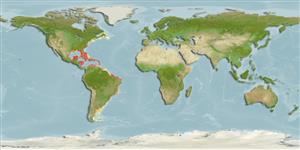Environment: milieu / climate zone / depth range / distribution range
Écologie
marin récifal; profondeur 1 - 37 m (Ref. 37039). Tropical
Western Atlantic: Florida (USA), Bahamas, and northern Gulf of Mexico to Brazil. Northwest Atlantic: Canada.
Length at first maturity / Taille / Poids / Âge
Maturity: Lm 33.2, range 28 - 38.7 cm
Max length : 43.0 cm TL (female)
Description synthétique
Morphologie | Morphométrie
Pale tan with scattered tiny spots. Mature individuals darker, with red-brown band at back of head. Dorsal fin origin above or behind anus (Ref. 26938).
Inhabits seagrass beds from bays and mangroves to offshore reefs. Adults move to open sea to spawn.
Life cycle and mating behavior
Maturité | Reproduction | Frai | Œufs | Fécondité | Larves
Distinct pairing (Ref. 205).
Robins, C.R. and G.C. Ray, 1986. A field guide to Atlantic coast fishes of North America. Houghton Mifflin Company, Boston, U.S.A. 354 p. (Ref. 7251)
Statut dans la liste rouge de l'IUCN (Ref. 130435)
Menace pour l'homme
Harmless
Utilisations par l'homme
Plus d'informations
Taille/ÂgeCroissanceLongueur-poidsLongueur-longueurFréquences de longueursMorphométrieMorphologieLarvesDynamique des populations larvairesRecrutementAbondanceBRUVS
RéférencesAquacultureProfil d'aquacultureSouchesGénétiqueElectrophoresesHéritabilitéPathologiesTraitementNutrientsMass conversion
Outils
Articles particuliers
Télécharger en XML
Sources Internet
Estimates based on models
Preferred temperature (Ref.
123201): 22.7 - 28, mean 26.4 °C (based on 356 cells).
Phylogenetic diversity index (Ref.
82804): PD
50 = 1.0000 [Uniqueness, from 0.5 = low to 2.0 = high].
Bayesian length-weight: a=0.00076 (0.00029 - 0.00199), b=3.06 (2.83 - 3.29), in cm total length, based on LWR estimates for this (Sub)family-body shape (Ref.
93245).
Niveau trophique (Ref.
69278): 4.1 ±0.7 se; based on size and trophs of closest relatives
Résilience (Ref.
120179): Haut, temps minimum de doublement de population inférieur à 15 mois (Preliminary K or Fecundity.).
Fishing Vulnerability (Ref.
59153): Low to moderate vulnerability (33 of 100).
Nutrients (Ref.
124155): Calcium = 56 [32, 104] mg/100g; Iron = 0.597 [0.363, 1.163] mg/100g; Protein = 18.7 [16.5, 21.3] %; Omega3 = 0.117 [0.054, 0.338] g/100g; Selenium = 38.2 [21.5, 76.5] μg/100g; VitaminA = 62 [18, 189] μg/100g; Zinc = 1.11 [0.79, 1.54] mg/100g (wet weight);
